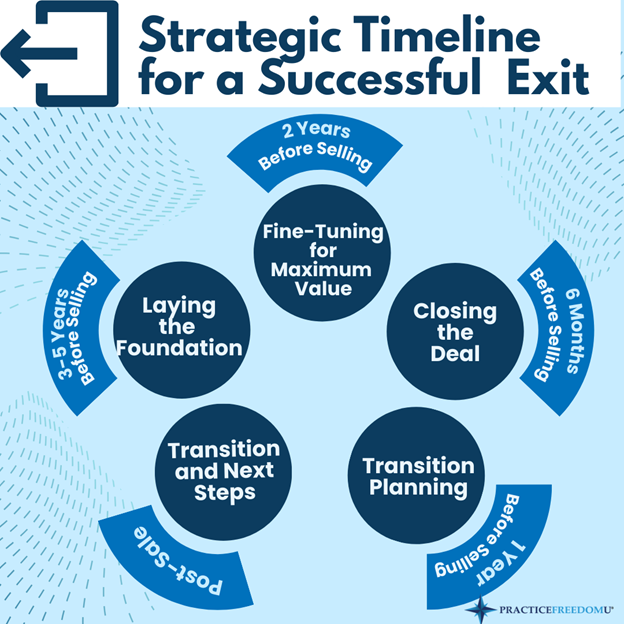Selling your physical therapy practice is one of the biggest decisions you’ll ever make. It’s not just a business transaction—it’s a transition from what you’ve built with years of hard work, late nights, and countless patient successes. If done right, selling your practice can be one of the most rewarding moments of your career, both financially and personally. But if done wrong—or worse, rushed—it can leave you feeling frustrated and disappointed.
The key to a successful sale is preparation. The earlier you start, the better. In this guide, we’ll break down the ideal timeline for maximizing the value of your practice and ensuring a smooth exit strategy.

2-5 Years Before Selling: Laying the Foundation
If you have even the slightest inkling that you might want to sell your practice in the next 3–5 years, now is the time to start preparing. Buyers want a well-oiled machine, not a fixer-upper. This phase is all about improving profitability, reducing your dependence on daily operations, and creating a business that is attractive to potential buyers. (Harvard Business School)
1. Optimize Your Financials
A buyer’s first question will be: “How profitable is this business?” If your financials are a mess, your practice’s value will suffer. Now is the time to:
- Clean up your books: Work with an accountant to ensure all revenue and expenses are accounted for properly.
- Increase profitability: Trim unnecessary expenses, optimize billing practices, and evaluate your payer mix.
- Establish consistent revenue streams: Consider adding wellness programs, cash-pay services, or membership models that generate recurring revenue.
2. Reduce Owner Dependency
If your practice can’t function without you, that’s a problem. Buyers want a business, not a job.
- Delegate patient care: Build a strong clinical team that can manage the majority of treatments.
- Systematize operations: Develop SOPs (Standard Operating Procedures) for key processes like scheduling, billing, and patient retention.
- Strengthen leadership: Promote or hire a clinic director to oversee daily operations.
3. Build a Strong Brand and Culture
A practice with a solid reputation, positive company culture, and engaged employees is far more attractive to buyers.
- Create a strong online presence: Ensure your website, social media, and online reviews reflect the high-quality care you provide.
- Retain top talent: Develop competitive compensation and benefits packages to reduce turnover.
- Engage your team: Foster a workplace culture that encourages staff retention and minimizes disruptions during ownership transitions.
2 Years Before Selling: Fine-Tuning for Maximum Value
By this point, you should have a profitable, well-run practice with a solid team in place. Now, it’s time to fine-tune the details that will make your business stand out in the marketplace. (Forbes)
1. Strengthen Your Referral and Marketing Systems
A steady stream of new and returning patients is essential.
- Automate marketing efforts: Invest in email campaigns, social media advertising, and local SEO to maintain a strong patient pipeline.
- Diversify referral sources: Don’t rely too heavily on a few referral sources—broaden your network.
- Measure key performance indicators (KPIs): Track conversion rates, patient retention, and revenue per visit to show consistent growth.
2. Secure Key Contracts and Agreements
Buyers want stability. Any uncertainty in contracts can be a red flag.
- Review lease agreements: Ensure your lease is buyer-friendly and won’t expire soon after the sale.
- Evaluate insurance contracts: Work with a consultant to ensure reimbursement rates are competitive.
- Lock in key staff members: Consider employee contracts with non-compete clauses to maintain consistency.
3. Conduct a Mock Due Diligence
Would your practice pass a buyer’s scrutiny today? Conduct a mock due diligence review to identify and fix any weak spots.
- Prepare financial statements and tax returns: Ensure they are accurate and up to date.
- Organize legal documents: Have all business licenses, contracts, and agreements in order.
- Review compliance: Make sure your practice meets all legal and regulatory requirements.
1 Year Before Selling: Transition Planning
The sale process itself can take 6–12 months, so at this stage, you should be getting everything ready for a smooth transition.
1. Identify and Qualify Potential Buyers
- Strategic buyers: Larger healthcare organizations, hospitals, or multi-location physical therapy groups.
- Financial buyers: Private equity firms or investors looking for a profitable, hands-off investment.
- Associate/partner buyout: Selling to an existing employee or partner within the practice.
2. Work with Professionals
Selling a practice is complex, so surround yourself with the right experts: (Entrepreneur)
- Business broker or M&A advisor: Helps market your practice and negotiate the sale.
- Attorney: Ensures all contracts and legal aspects are covered.
- Accountant: Helps minimize tax liabilities and prepare financial documents.
3. Prepare for Buyer Scrutiny
By now, everything should be in order. Buyers will conduct extensive due diligence, so be ready with:
- Financial records from the past 3–5 years.
- Staffing details, including contracts and compensation.
- Operational manuals and SOPs.
6 Months Before Selling: Closing the Deal
You’re in the home stretch. This period is all about finalizing the deal and ensuring a seamless transition.
1. Negotiate the Sale Price and Terms
- Know your bottom line: Understand the lowest price you’re willing to accept.
- Consider seller financing: Some buyers may request owner financing for part of the purchase.
- Clarify transition expectations: Will you stay on for a transition period? If so, for how long?
2. Communicate with Your Team and Patients
Once the deal is finalized, be transparent with your staff.
- Announce the transition: Address concerns and reassure employees about job security.
- Introduce the new owner: A smooth handoff reduces patient attrition and staff turnover.
3. Finalize Legal and Financial Details
- Complete asset transfer and legal documents.
- Settle any outstanding liabilities.
- Ensure the new owner has all necessary credentials and licensing.
Post-Sale: Transition and Next Steps
Congratulations! You’ve successfully sold your practice. But what comes next?
- Honor any agreed-upon transition period.
- Assist with training the new owner and team as needed.
- Plan your next chapter: Whether it’s retirement, consulting, or starting a new business, embrace the opportunities ahead.
Exit planning isn’t something you do last-minute. The most successful practice sales happen when owners prepare well in advance, focusing on profitability, scalability, and operational efficiency. By following this timeline, you’ll not only maximize the value of your practice but also ensure a smooth transition for your staff, patients, and yourself.
Practice Freedom and Exit Planning
One of the most important yet overlooked aspects of preparing to sell your practice is achieving what I call “practice freedom.” This means creating a business that runs efficiently without you being involved in every single decision. When your practice has systems, processes, and a team that can operate independently, it not only makes your life easier but also significantly increases the value of your business to a potential buyer. Buyers aren’t looking to purchase a job—they want a growth-ready, sustainable business. By implementing solid leadership, operational efficiency, and financial stability, you set yourself up for a more profitable and seamless transition when the time comes to sell.
The best time to start planning your exit? Yesterday. The second-best time? Today.
————————————————————-
Are you ready for a coach? Join the hundreds of physical therapy owners who are building the practice of their dreams with the support, guidance and direction of a Practice Freedom U Coach. Take the first step towards creating a business that sets you free by scheduling a Discovery Call



